Strategic Management: Tesco Strategy Evaluation Report
VerifiedAdded on 2023/01/11
|12
|3492
|24
Report
AI Summary
This report offers a comprehensive strategic evaluation of Tesco, a leading UK retailer. It begins by defining strategy and evaluating Tesco's mission, vision, values, and objectives. The report then assesses Tesco's competitive advantage using the VRIO framework, identifying resources that contribute to its sustained competitive advantage. An external environmental analysis is conducted using the PESTLE framework, examining political, economic, social, technological, legal, and environmental factors. The application of Porter's Five Forces Model assesses the industry's attractiveness. Finally, the report reviews Tesco's current business strategy and suggests potential improvements. The analysis provides insights into Tesco's position in the retail market, its strengths, and the challenges it faces, offering a strategic perspective on the company's operations and future direction.
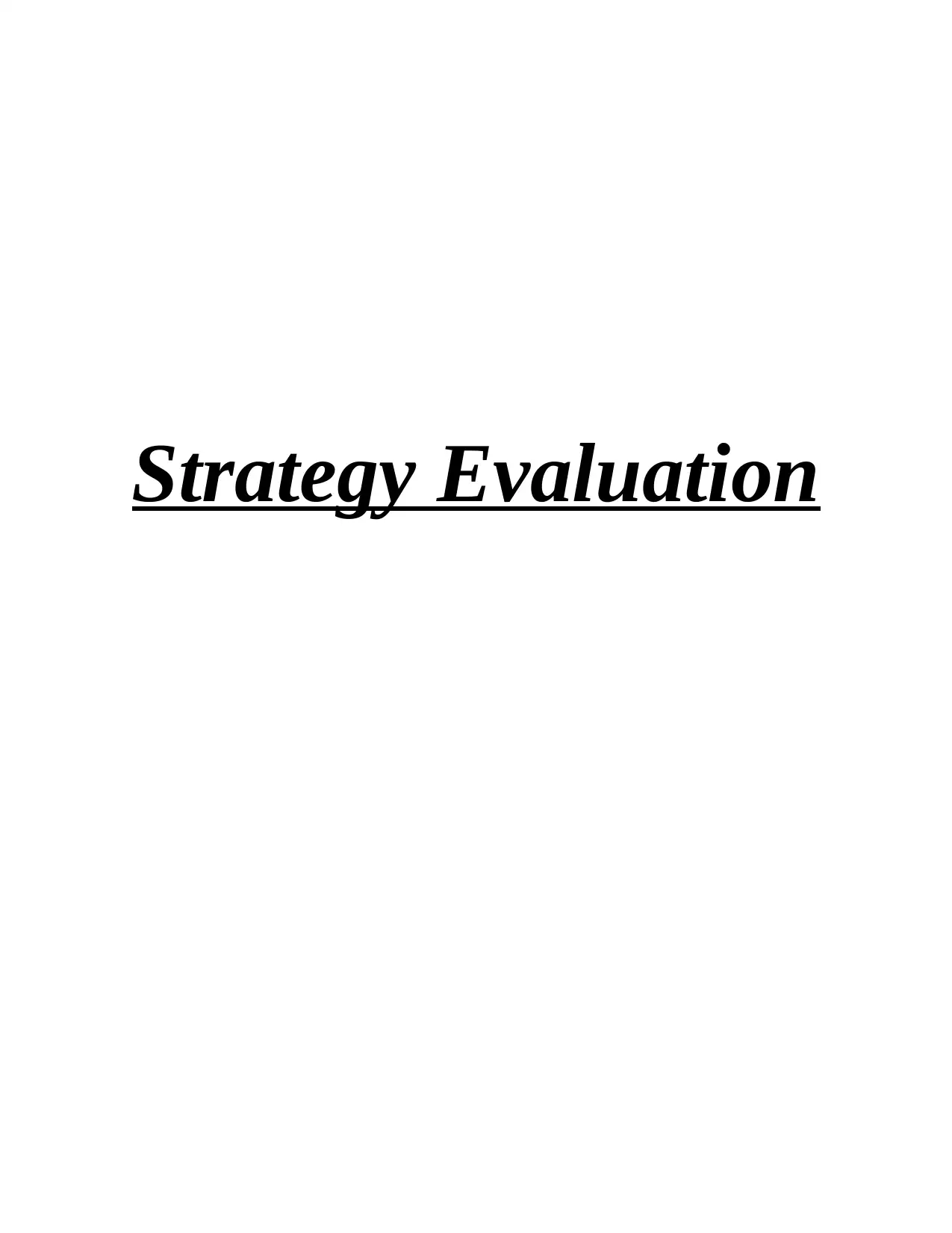
Strategy Evaluation
Paraphrase This Document
Need a fresh take? Get an instant paraphrase of this document with our AI Paraphraser
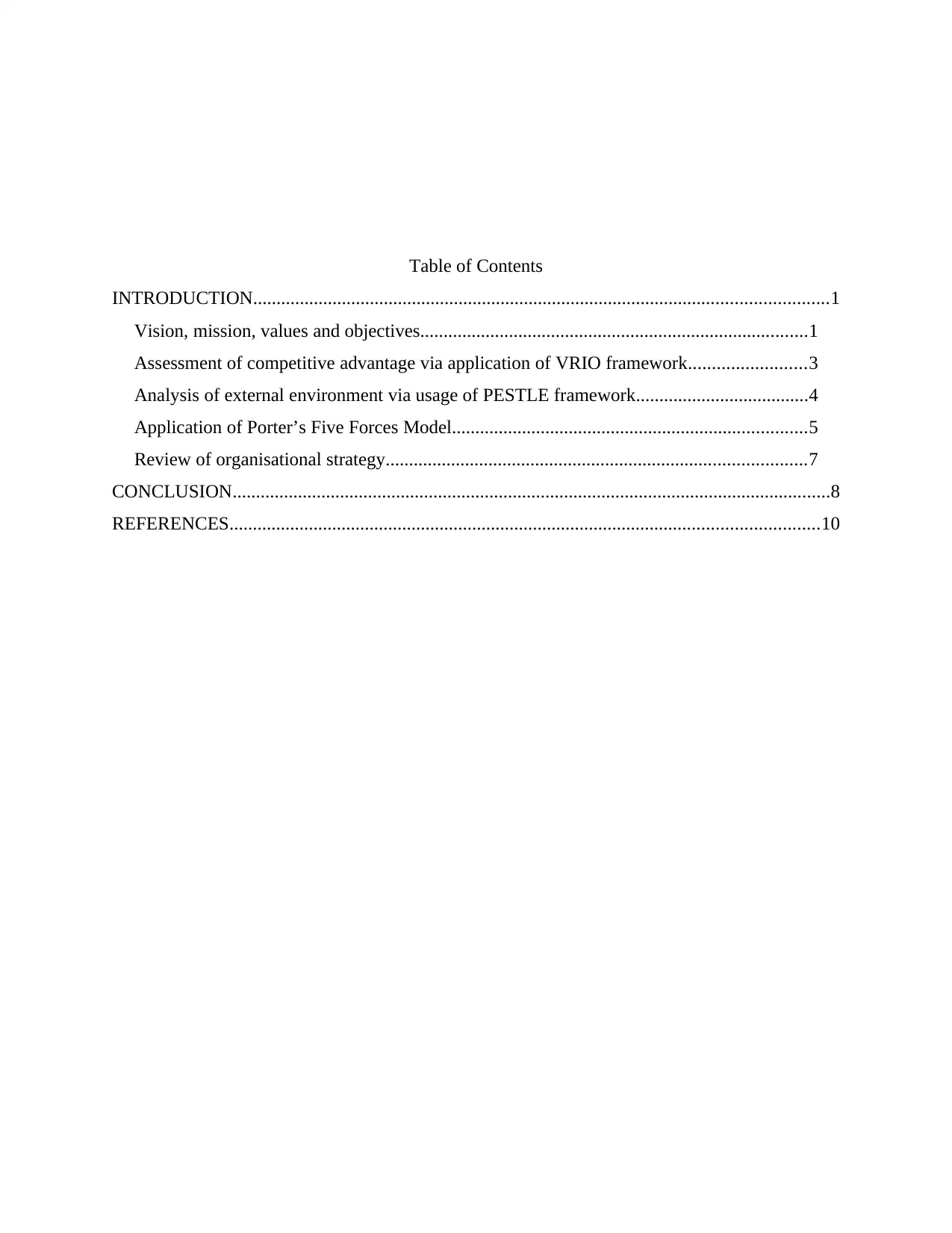
Table of Contents
INTRODUCTION...........................................................................................................................1
Vision, mission, values and objectives...................................................................................1
Assessment of competitive advantage via application of VRIO framework.........................3
Analysis of external environment via usage of PESTLE framework.....................................4
Application of Porter’s Five Forces Model............................................................................5
Review of organisational strategy..........................................................................................7
CONCLUSION................................................................................................................................8
REFERENCES..............................................................................................................................10
INTRODUCTION...........................................................................................................................1
Vision, mission, values and objectives...................................................................................1
Assessment of competitive advantage via application of VRIO framework.........................3
Analysis of external environment via usage of PESTLE framework.....................................4
Application of Porter’s Five Forces Model............................................................................5
Review of organisational strategy..........................................................................................7
CONCLUSION................................................................................................................................8
REFERENCES..............................................................................................................................10
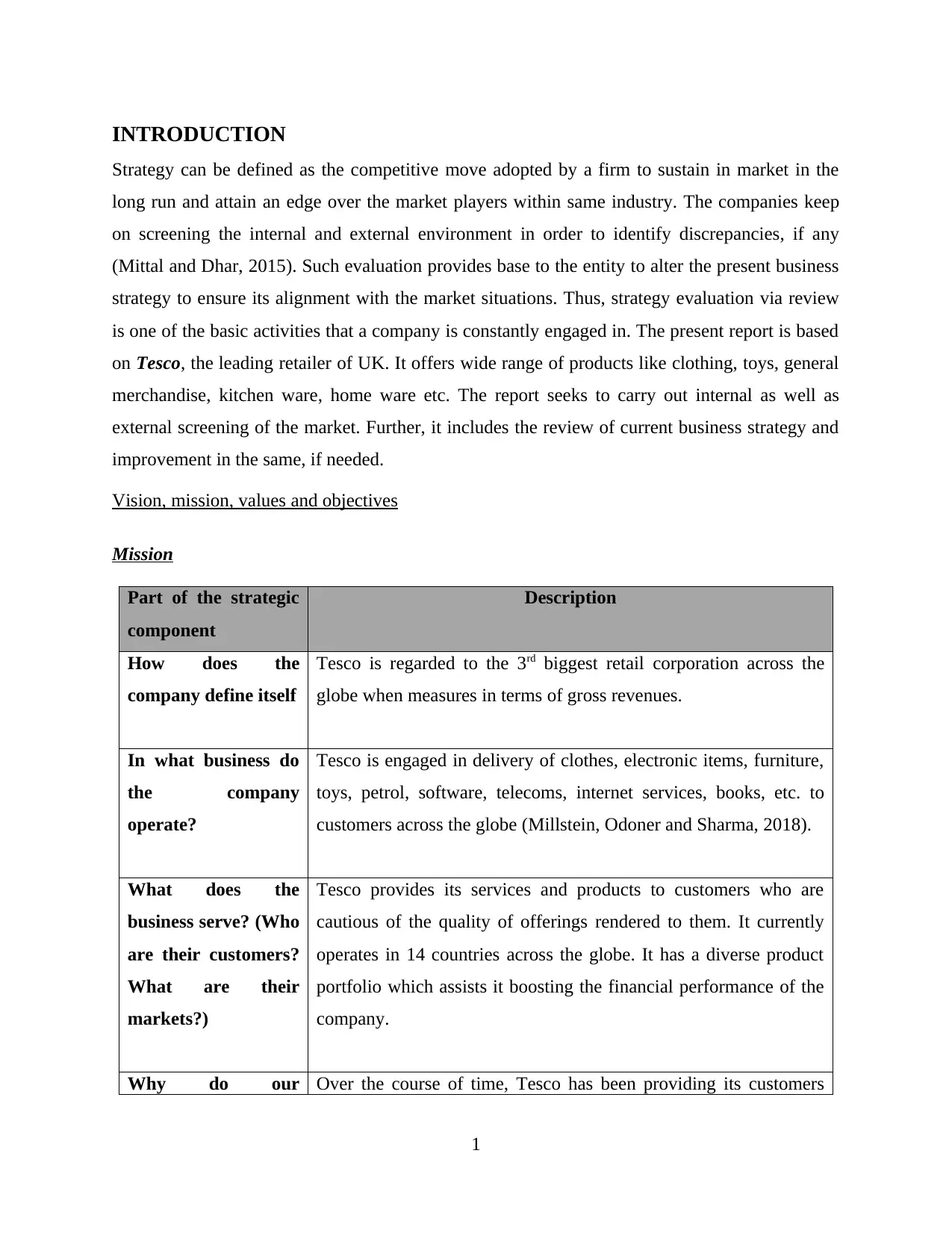
INTRODUCTION
Strategy can be defined as the competitive move adopted by a firm to sustain in market in the
long run and attain an edge over the market players within same industry. The companies keep
on screening the internal and external environment in order to identify discrepancies, if any
(Mittal and Dhar, 2015). Such evaluation provides base to the entity to alter the present business
strategy to ensure its alignment with the market situations. Thus, strategy evaluation via review
is one of the basic activities that a company is constantly engaged in. The present report is based
on Tesco, the leading retailer of UK. It offers wide range of products like clothing, toys, general
merchandise, kitchen ware, home ware etc. The report seeks to carry out internal as well as
external screening of the market. Further, it includes the review of current business strategy and
improvement in the same, if needed.
Vision, mission, values and objectives
Mission
Part of the strategic
component
Description
How does the
company define itself
Tesco is regarded to the 3rd biggest retail corporation across the
globe when measures in terms of gross revenues.
In what business do
the company
operate?
Tesco is engaged in delivery of clothes, electronic items, furniture,
toys, petrol, software, telecoms, internet services, books, etc. to
customers across the globe (Millstein, Odoner and Sharma, 2018).
What does the
business serve? (Who
are their customers?
What are their
markets?)
Tesco provides its services and products to customers who are
cautious of the quality of offerings rendered to them. It currently
operates in 14 countries across the globe. It has a diverse product
portfolio which assists it boosting the financial performance of the
company.
Why do our Over the course of time, Tesco has been providing its customers
1
Strategy can be defined as the competitive move adopted by a firm to sustain in market in the
long run and attain an edge over the market players within same industry. The companies keep
on screening the internal and external environment in order to identify discrepancies, if any
(Mittal and Dhar, 2015). Such evaluation provides base to the entity to alter the present business
strategy to ensure its alignment with the market situations. Thus, strategy evaluation via review
is one of the basic activities that a company is constantly engaged in. The present report is based
on Tesco, the leading retailer of UK. It offers wide range of products like clothing, toys, general
merchandise, kitchen ware, home ware etc. The report seeks to carry out internal as well as
external screening of the market. Further, it includes the review of current business strategy and
improvement in the same, if needed.
Vision, mission, values and objectives
Mission
Part of the strategic
component
Description
How does the
company define itself
Tesco is regarded to the 3rd biggest retail corporation across the
globe when measures in terms of gross revenues.
In what business do
the company
operate?
Tesco is engaged in delivery of clothes, electronic items, furniture,
toys, petrol, software, telecoms, internet services, books, etc. to
customers across the globe (Millstein, Odoner and Sharma, 2018).
What does the
business serve? (Who
are their customers?
What are their
markets?)
Tesco provides its services and products to customers who are
cautious of the quality of offerings rendered to them. It currently
operates in 14 countries across the globe. It has a diverse product
portfolio which assists it boosting the financial performance of the
company.
Why do our Over the course of time, Tesco has been providing its customers
1
⊘ This is a preview!⊘
Do you want full access?
Subscribe today to unlock all pages.

Trusted by 1+ million students worldwide
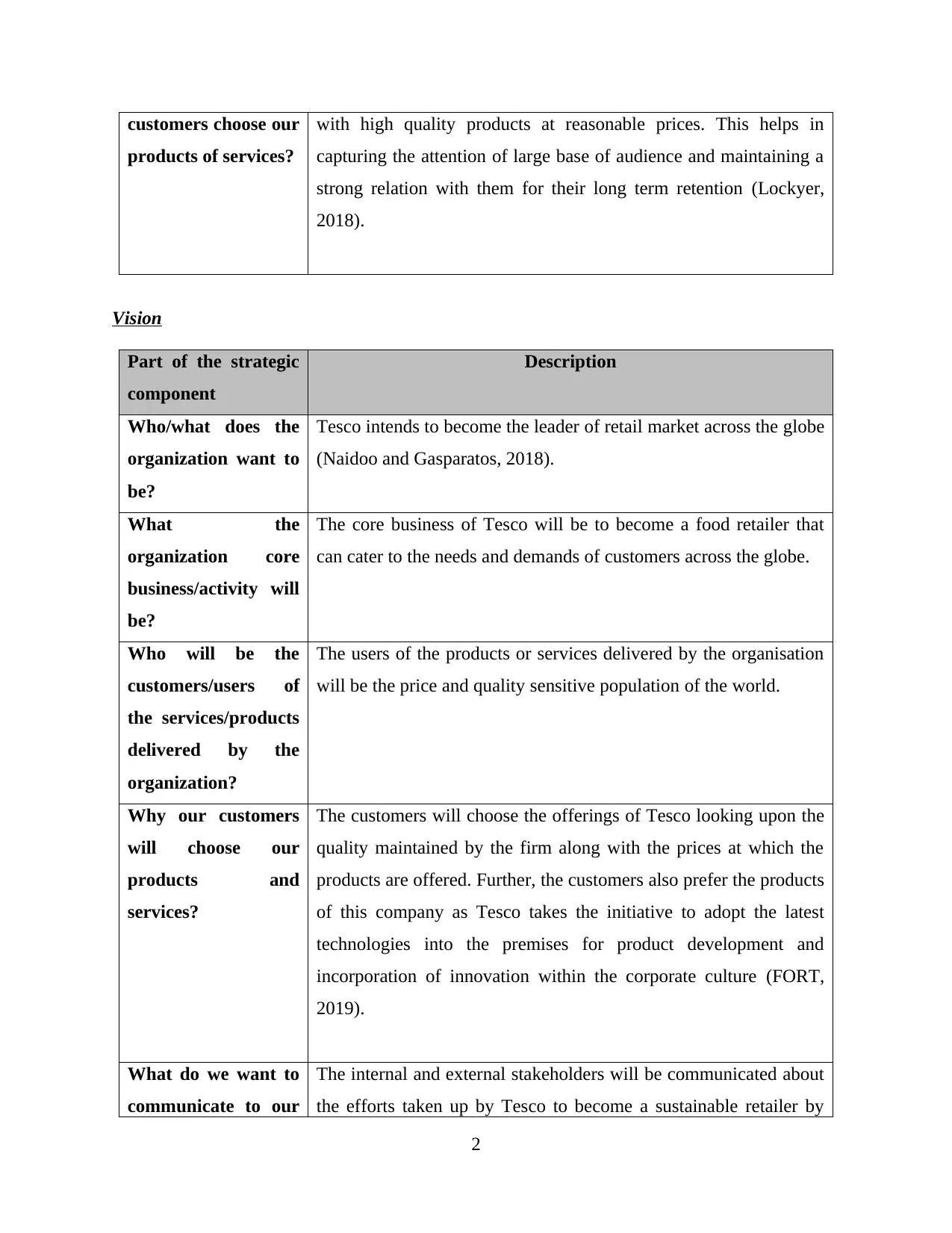
customers choose our
products of services?
with high quality products at reasonable prices. This helps in
capturing the attention of large base of audience and maintaining a
strong relation with them for their long term retention (Lockyer,
2018).
Vision
Part of the strategic
component
Description
Who/what does the
organization want to
be?
Tesco intends to become the leader of retail market across the globe
(Naidoo and Gasparatos, 2018).
What the
organization core
business/activity will
be?
The core business of Tesco will be to become a food retailer that
can cater to the needs and demands of customers across the globe.
Who will be the
customers/users of
the services/products
delivered by the
organization?
The users of the products or services delivered by the organisation
will be the price and quality sensitive population of the world.
Why our customers
will choose our
products and
services?
The customers will choose the offerings of Tesco looking upon the
quality maintained by the firm along with the prices at which the
products are offered. Further, the customers also prefer the products
of this company as Tesco takes the initiative to adopt the latest
technologies into the premises for product development and
incorporation of innovation within the corporate culture (FORT,
2019).
What do we want to
communicate to our
The internal and external stakeholders will be communicated about
the efforts taken up by Tesco to become a sustainable retailer by
2
products of services?
with high quality products at reasonable prices. This helps in
capturing the attention of large base of audience and maintaining a
strong relation with them for their long term retention (Lockyer,
2018).
Vision
Part of the strategic
component
Description
Who/what does the
organization want to
be?
Tesco intends to become the leader of retail market across the globe
(Naidoo and Gasparatos, 2018).
What the
organization core
business/activity will
be?
The core business of Tesco will be to become a food retailer that
can cater to the needs and demands of customers across the globe.
Who will be the
customers/users of
the services/products
delivered by the
organization?
The users of the products or services delivered by the organisation
will be the price and quality sensitive population of the world.
Why our customers
will choose our
products and
services?
The customers will choose the offerings of Tesco looking upon the
quality maintained by the firm along with the prices at which the
products are offered. Further, the customers also prefer the products
of this company as Tesco takes the initiative to adopt the latest
technologies into the premises for product development and
incorporation of innovation within the corporate culture (FORT,
2019).
What do we want to
communicate to our
The internal and external stakeholders will be communicated about
the efforts taken up by Tesco to become a sustainable retailer by
2
Paraphrase This Document
Need a fresh take? Get an instant paraphrase of this document with our AI Paraphraser
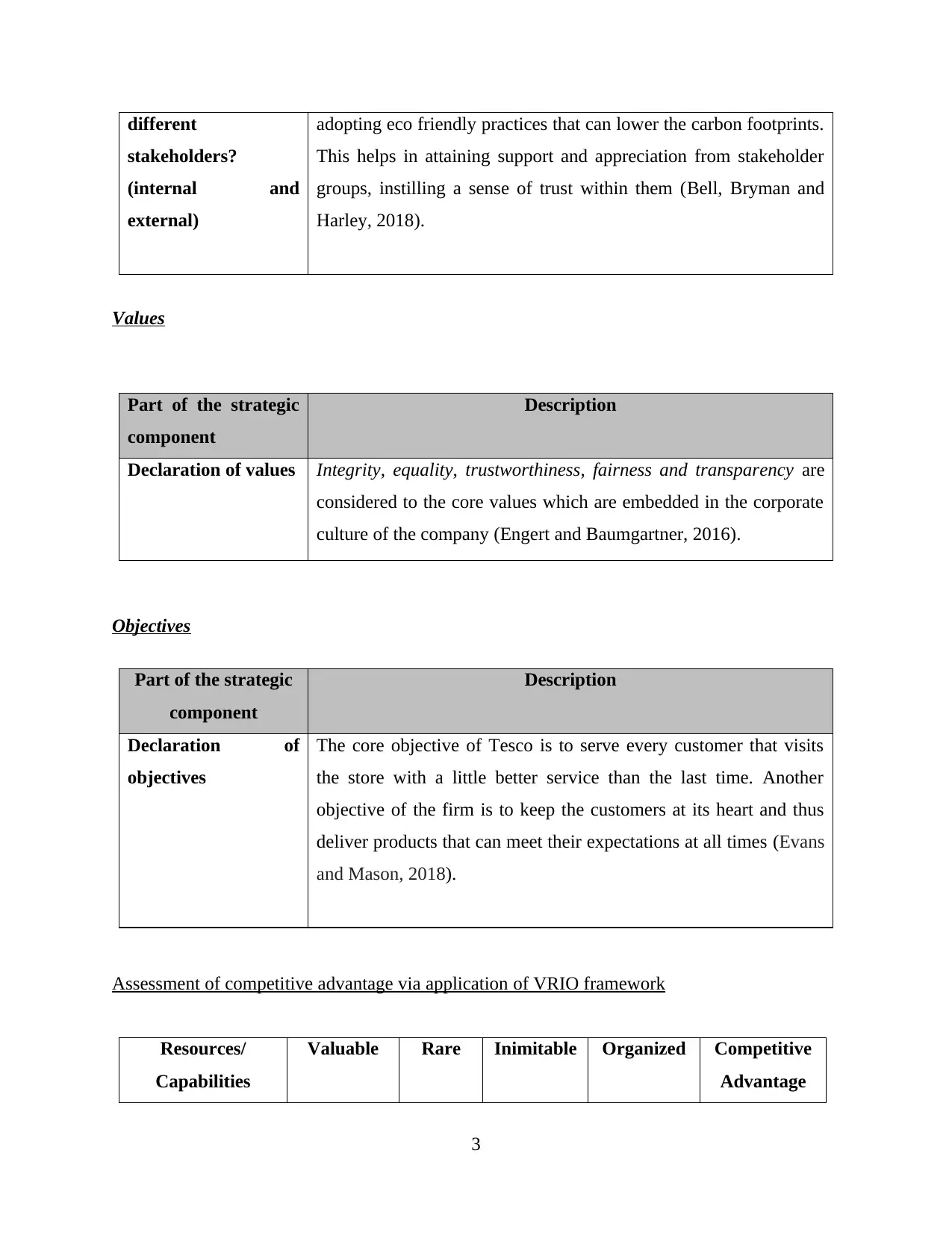
different
stakeholders?
(internal and
external)
adopting eco friendly practices that can lower the carbon footprints.
This helps in attaining support and appreciation from stakeholder
groups, instilling a sense of trust within them (Bell, Bryman and
Harley, 2018).
Values
Part of the strategic
component
Description
Declaration of values Integrity, equality, trustworthiness, fairness and transparency are
considered to the core values which are embedded in the corporate
culture of the company (Engert and Baumgartner, 2016).
Objectives
Part of the strategic
component
Description
Declaration of
objectives
The core objective of Tesco is to serve every customer that visits
the store with a little better service than the last time. Another
objective of the firm is to keep the customers at its heart and thus
deliver products that can meet their expectations at all times (Evans
and Mason, 2018).
Assessment of competitive advantage via application of VRIO framework
Resources/
Capabilities
Valuable Rare Inimitable Organized Competitive
Advantage
3
stakeholders?
(internal and
external)
adopting eco friendly practices that can lower the carbon footprints.
This helps in attaining support and appreciation from stakeholder
groups, instilling a sense of trust within them (Bell, Bryman and
Harley, 2018).
Values
Part of the strategic
component
Description
Declaration of values Integrity, equality, trustworthiness, fairness and transparency are
considered to the core values which are embedded in the corporate
culture of the company (Engert and Baumgartner, 2016).
Objectives
Part of the strategic
component
Description
Declaration of
objectives
The core objective of Tesco is to serve every customer that visits
the store with a little better service than the last time. Another
objective of the firm is to keep the customers at its heart and thus
deliver products that can meet their expectations at all times (Evans
and Mason, 2018).
Assessment of competitive advantage via application of VRIO framework
Resources/
Capabilities
Valuable Rare Inimitable Organized Competitive
Advantage
3
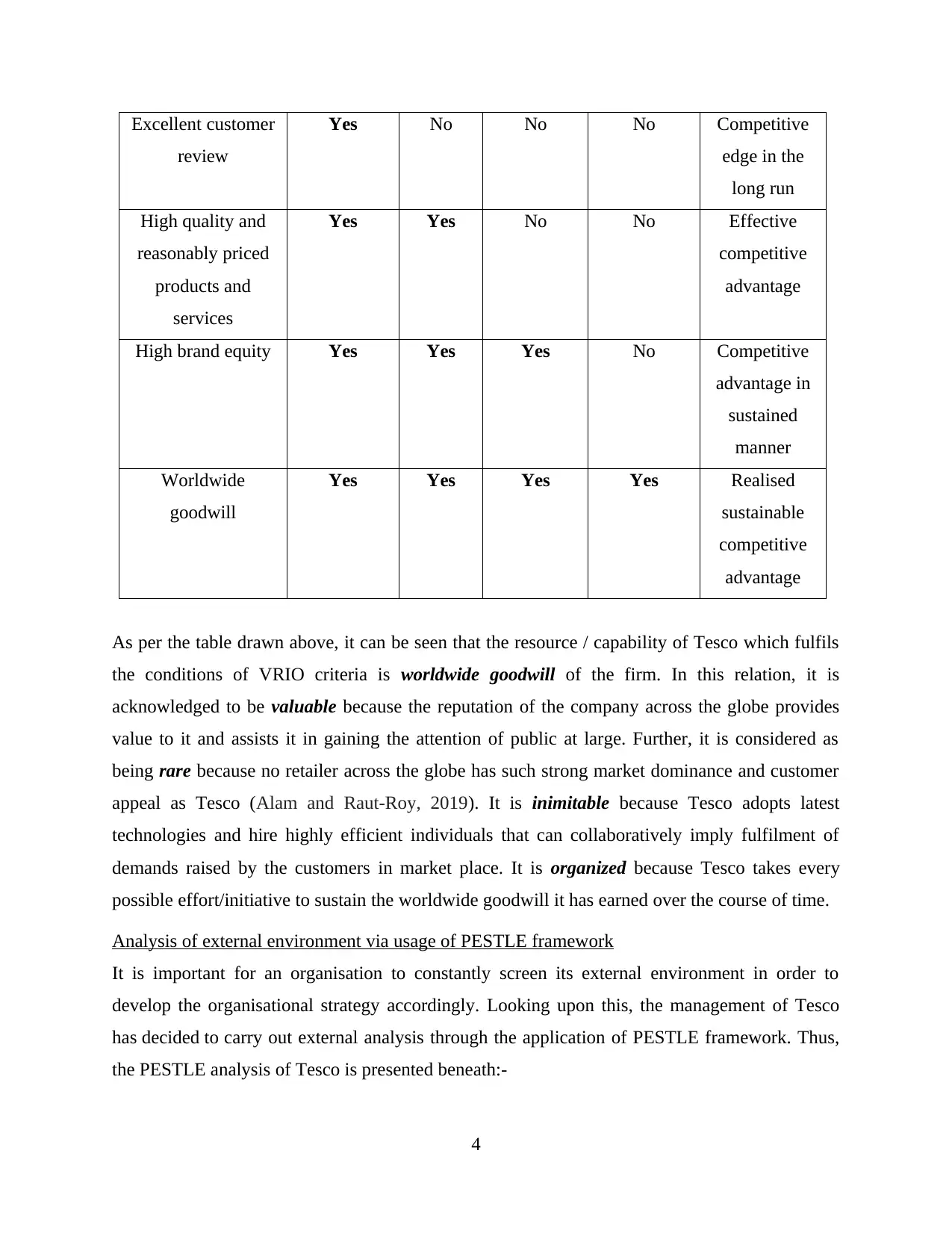
Excellent customer
review
Yes No No No Competitive
edge in the
long run
High quality and
reasonably priced
products and
services
Yes Yes No No Effective
competitive
advantage
High brand equity Yes Yes Yes No Competitive
advantage in
sustained
manner
Worldwide
goodwill
Yes Yes Yes Yes Realised
sustainable
competitive
advantage
As per the table drawn above, it can be seen that the resource / capability of Tesco which fulfils
the conditions of VRIO criteria is worldwide goodwill of the firm. In this relation, it is
acknowledged to be valuable because the reputation of the company across the globe provides
value to it and assists it in gaining the attention of public at large. Further, it is considered as
being rare because no retailer across the globe has such strong market dominance and customer
appeal as Tesco (Alam and Raut-Roy, 2019). It is inimitable because Tesco adopts latest
technologies and hire highly efficient individuals that can collaboratively imply fulfilment of
demands raised by the customers in market place. It is organized because Tesco takes every
possible effort/initiative to sustain the worldwide goodwill it has earned over the course of time.
Analysis of external environment via usage of PESTLE framework
It is important for an organisation to constantly screen its external environment in order to
develop the organisational strategy accordingly. Looking upon this, the management of Tesco
has decided to carry out external analysis through the application of PESTLE framework. Thus,
the PESTLE analysis of Tesco is presented beneath:-
4
review
Yes No No No Competitive
edge in the
long run
High quality and
reasonably priced
products and
services
Yes Yes No No Effective
competitive
advantage
High brand equity Yes Yes Yes No Competitive
advantage in
sustained
manner
Worldwide
goodwill
Yes Yes Yes Yes Realised
sustainable
competitive
advantage
As per the table drawn above, it can be seen that the resource / capability of Tesco which fulfils
the conditions of VRIO criteria is worldwide goodwill of the firm. In this relation, it is
acknowledged to be valuable because the reputation of the company across the globe provides
value to it and assists it in gaining the attention of public at large. Further, it is considered as
being rare because no retailer across the globe has such strong market dominance and customer
appeal as Tesco (Alam and Raut-Roy, 2019). It is inimitable because Tesco adopts latest
technologies and hire highly efficient individuals that can collaboratively imply fulfilment of
demands raised by the customers in market place. It is organized because Tesco takes every
possible effort/initiative to sustain the worldwide goodwill it has earned over the course of time.
Analysis of external environment via usage of PESTLE framework
It is important for an organisation to constantly screen its external environment in order to
develop the organisational strategy accordingly. Looking upon this, the management of Tesco
has decided to carry out external analysis through the application of PESTLE framework. Thus,
the PESTLE analysis of Tesco is presented beneath:-
4
⊘ This is a preview!⊘
Do you want full access?
Subscribe today to unlock all pages.

Trusted by 1+ million students worldwide
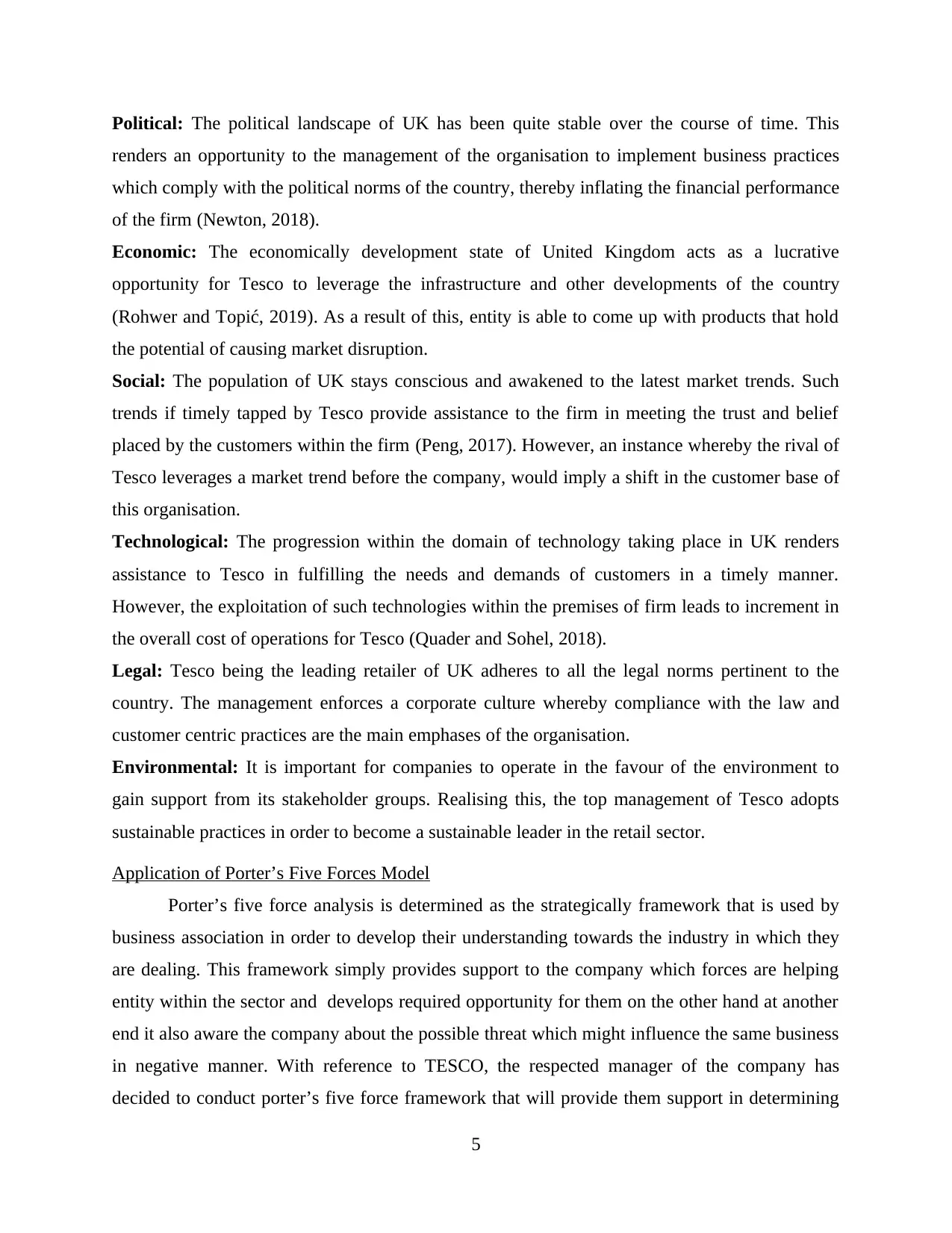
Political: The political landscape of UK has been quite stable over the course of time. This
renders an opportunity to the management of the organisation to implement business practices
which comply with the political norms of the country, thereby inflating the financial performance
of the firm (Newton, 2018).
Economic: The economically development state of United Kingdom acts as a lucrative
opportunity for Tesco to leverage the infrastructure and other developments of the country
(Rohwer and Topić, 2019). As a result of this, entity is able to come up with products that hold
the potential of causing market disruption.
Social: The population of UK stays conscious and awakened to the latest market trends. Such
trends if timely tapped by Tesco provide assistance to the firm in meeting the trust and belief
placed by the customers within the firm (Peng, 2017). However, an instance whereby the rival of
Tesco leverages a market trend before the company, would imply a shift in the customer base of
this organisation.
Technological: The progression within the domain of technology taking place in UK renders
assistance to Tesco in fulfilling the needs and demands of customers in a timely manner.
However, the exploitation of such technologies within the premises of firm leads to increment in
the overall cost of operations for Tesco (Quader and Sohel, 2018).
Legal: Tesco being the leading retailer of UK adheres to all the legal norms pertinent to the
country. The management enforces a corporate culture whereby compliance with the law and
customer centric practices are the main emphases of the organisation.
Environmental: It is important for companies to operate in the favour of the environment to
gain support from its stakeholder groups. Realising this, the top management of Tesco adopts
sustainable practices in order to become a sustainable leader in the retail sector.
Application of Porter’s Five Forces Model
Porter’s five force analysis is determined as the strategically framework that is used by
business association in order to develop their understanding towards the industry in which they
are dealing. This framework simply provides support to the company which forces are helping
entity within the sector and develops required opportunity for them on the other hand at another
end it also aware the company about the possible threat which might influence the same business
in negative manner. With reference to TESCO, the respected manager of the company has
decided to conduct porter’s five force framework that will provide them support in determining
5
renders an opportunity to the management of the organisation to implement business practices
which comply with the political norms of the country, thereby inflating the financial performance
of the firm (Newton, 2018).
Economic: The economically development state of United Kingdom acts as a lucrative
opportunity for Tesco to leverage the infrastructure and other developments of the country
(Rohwer and Topić, 2019). As a result of this, entity is able to come up with products that hold
the potential of causing market disruption.
Social: The population of UK stays conscious and awakened to the latest market trends. Such
trends if timely tapped by Tesco provide assistance to the firm in meeting the trust and belief
placed by the customers within the firm (Peng, 2017). However, an instance whereby the rival of
Tesco leverages a market trend before the company, would imply a shift in the customer base of
this organisation.
Technological: The progression within the domain of technology taking place in UK renders
assistance to Tesco in fulfilling the needs and demands of customers in a timely manner.
However, the exploitation of such technologies within the premises of firm leads to increment in
the overall cost of operations for Tesco (Quader and Sohel, 2018).
Legal: Tesco being the leading retailer of UK adheres to all the legal norms pertinent to the
country. The management enforces a corporate culture whereby compliance with the law and
customer centric practices are the main emphases of the organisation.
Environmental: It is important for companies to operate in the favour of the environment to
gain support from its stakeholder groups. Realising this, the top management of Tesco adopts
sustainable practices in order to become a sustainable leader in the retail sector.
Application of Porter’s Five Forces Model
Porter’s five force analysis is determined as the strategically framework that is used by
business association in order to develop their understanding towards the industry in which they
are dealing. This framework simply provides support to the company which forces are helping
entity within the sector and develops required opportunity for them on the other hand at another
end it also aware the company about the possible threat which might influence the same business
in negative manner. With reference to TESCO, the respected manager of the company has
decided to conduct porter’s five force framework that will provide them support in determining
5
Paraphrase This Document
Need a fresh take? Get an instant paraphrase of this document with our AI Paraphraser
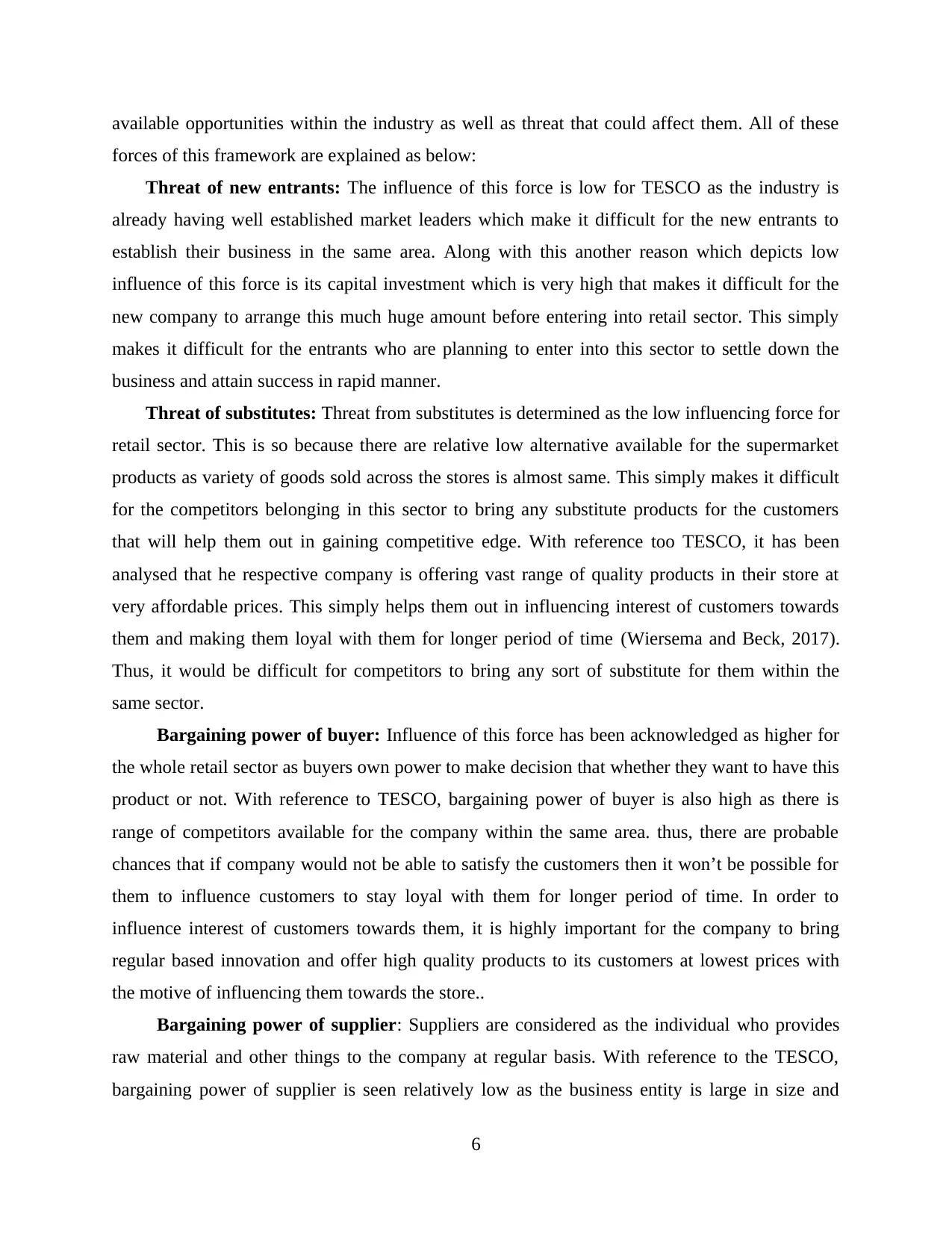
available opportunities within the industry as well as threat that could affect them. All of these
forces of this framework are explained as below:
Threat of new entrants: The influence of this force is low for TESCO as the industry is
already having well established market leaders which make it difficult for the new entrants to
establish their business in the same area. Along with this another reason which depicts low
influence of this force is its capital investment which is very high that makes it difficult for the
new company to arrange this much huge amount before entering into retail sector. This simply
makes it difficult for the entrants who are planning to enter into this sector to settle down the
business and attain success in rapid manner.
Threat of substitutes: Threat from substitutes is determined as the low influencing force for
retail sector. This is so because there are relative low alternative available for the supermarket
products as variety of goods sold across the stores is almost same. This simply makes it difficult
for the competitors belonging in this sector to bring any substitute products for the customers
that will help them out in gaining competitive edge. With reference too TESCO, it has been
analysed that he respective company is offering vast range of quality products in their store at
very affordable prices. This simply helps them out in influencing interest of customers towards
them and making them loyal with them for longer period of time (Wiersema and Beck, 2017).
Thus, it would be difficult for competitors to bring any sort of substitute for them within the
same sector.
Bargaining power of buyer: Influence of this force has been acknowledged as higher for
the whole retail sector as buyers own power to make decision that whether they want to have this
product or not. With reference to TESCO, bargaining power of buyer is also high as there is
range of competitors available for the company within the same area. thus, there are probable
chances that if company would not be able to satisfy the customers then it won’t be possible for
them to influence customers to stay loyal with them for longer period of time. In order to
influence interest of customers towards them, it is highly important for the company to bring
regular based innovation and offer high quality products to its customers at lowest prices with
the motive of influencing them towards the store..
Bargaining power of supplier: Suppliers are considered as the individual who provides
raw material and other things to the company at regular basis. With reference to the TESCO,
bargaining power of supplier is seen relatively low as the business entity is large in size and
6
forces of this framework are explained as below:
Threat of new entrants: The influence of this force is low for TESCO as the industry is
already having well established market leaders which make it difficult for the new entrants to
establish their business in the same area. Along with this another reason which depicts low
influence of this force is its capital investment which is very high that makes it difficult for the
new company to arrange this much huge amount before entering into retail sector. This simply
makes it difficult for the entrants who are planning to enter into this sector to settle down the
business and attain success in rapid manner.
Threat of substitutes: Threat from substitutes is determined as the low influencing force for
retail sector. This is so because there are relative low alternative available for the supermarket
products as variety of goods sold across the stores is almost same. This simply makes it difficult
for the competitors belonging in this sector to bring any substitute products for the customers
that will help them out in gaining competitive edge. With reference too TESCO, it has been
analysed that he respective company is offering vast range of quality products in their store at
very affordable prices. This simply helps them out in influencing interest of customers towards
them and making them loyal with them for longer period of time (Wiersema and Beck, 2017).
Thus, it would be difficult for competitors to bring any sort of substitute for them within the
same sector.
Bargaining power of buyer: Influence of this force has been acknowledged as higher for
the whole retail sector as buyers own power to make decision that whether they want to have this
product or not. With reference to TESCO, bargaining power of buyer is also high as there is
range of competitors available for the company within the same area. thus, there are probable
chances that if company would not be able to satisfy the customers then it won’t be possible for
them to influence customers to stay loyal with them for longer period of time. In order to
influence interest of customers towards them, it is highly important for the company to bring
regular based innovation and offer high quality products to its customers at lowest prices with
the motive of influencing them towards the store..
Bargaining power of supplier: Suppliers are considered as the individual who provides
raw material and other things to the company at regular basis. With reference to the TESCO,
bargaining power of supplier is seen relatively low as the business entity is large in size and
6
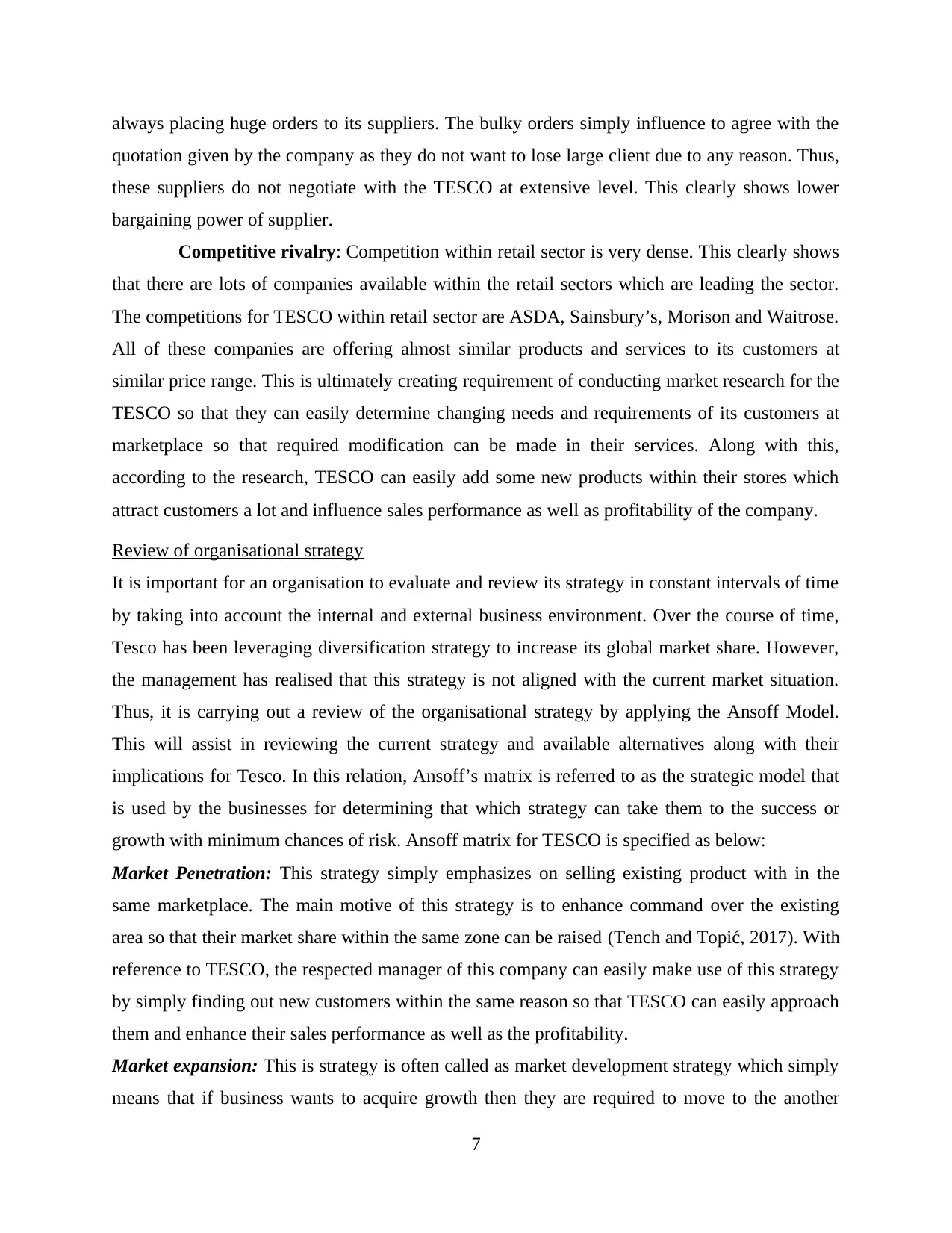
always placing huge orders to its suppliers. The bulky orders simply influence to agree with the
quotation given by the company as they do not want to lose large client due to any reason. Thus,
these suppliers do not negotiate with the TESCO at extensive level. This clearly shows lower
bargaining power of supplier.
Competitive rivalry: Competition within retail sector is very dense. This clearly shows
that there are lots of companies available within the retail sectors which are leading the sector.
The competitions for TESCO within retail sector are ASDA, Sainsbury’s, Morison and Waitrose.
All of these companies are offering almost similar products and services to its customers at
similar price range. This is ultimately creating requirement of conducting market research for the
TESCO so that they can easily determine changing needs and requirements of its customers at
marketplace so that required modification can be made in their services. Along with this,
according to the research, TESCO can easily add some new products within their stores which
attract customers a lot and influence sales performance as well as profitability of the company.
Review of organisational strategy
It is important for an organisation to evaluate and review its strategy in constant intervals of time
by taking into account the internal and external business environment. Over the course of time,
Tesco has been leveraging diversification strategy to increase its global market share. However,
the management has realised that this strategy is not aligned with the current market situation.
Thus, it is carrying out a review of the organisational strategy by applying the Ansoff Model.
This will assist in reviewing the current strategy and available alternatives along with their
implications for Tesco. In this relation, Ansoff’s matrix is referred to as the strategic model that
is used by the businesses for determining that which strategy can take them to the success or
growth with minimum chances of risk. Ansoff matrix for TESCO is specified as below:
Market Penetration: This strategy simply emphasizes on selling existing product with in the
same marketplace. The main motive of this strategy is to enhance command over the existing
area so that their market share within the same zone can be raised (Tench and Topić, 2017). With
reference to TESCO, the respected manager of this company can easily make use of this strategy
by simply finding out new customers within the same reason so that TESCO can easily approach
them and enhance their sales performance as well as the profitability.
Market expansion: This is strategy is often called as market development strategy which simply
means that if business wants to acquire growth then they are required to move to the another
7
quotation given by the company as they do not want to lose large client due to any reason. Thus,
these suppliers do not negotiate with the TESCO at extensive level. This clearly shows lower
bargaining power of supplier.
Competitive rivalry: Competition within retail sector is very dense. This clearly shows
that there are lots of companies available within the retail sectors which are leading the sector.
The competitions for TESCO within retail sector are ASDA, Sainsbury’s, Morison and Waitrose.
All of these companies are offering almost similar products and services to its customers at
similar price range. This is ultimately creating requirement of conducting market research for the
TESCO so that they can easily determine changing needs and requirements of its customers at
marketplace so that required modification can be made in their services. Along with this,
according to the research, TESCO can easily add some new products within their stores which
attract customers a lot and influence sales performance as well as profitability of the company.
Review of organisational strategy
It is important for an organisation to evaluate and review its strategy in constant intervals of time
by taking into account the internal and external business environment. Over the course of time,
Tesco has been leveraging diversification strategy to increase its global market share. However,
the management has realised that this strategy is not aligned with the current market situation.
Thus, it is carrying out a review of the organisational strategy by applying the Ansoff Model.
This will assist in reviewing the current strategy and available alternatives along with their
implications for Tesco. In this relation, Ansoff’s matrix is referred to as the strategic model that
is used by the businesses for determining that which strategy can take them to the success or
growth with minimum chances of risk. Ansoff matrix for TESCO is specified as below:
Market Penetration: This strategy simply emphasizes on selling existing product with in the
same marketplace. The main motive of this strategy is to enhance command over the existing
area so that their market share within the same zone can be raised (Tench and Topić, 2017). With
reference to TESCO, the respected manager of this company can easily make use of this strategy
by simply finding out new customers within the same reason so that TESCO can easily approach
them and enhance their sales performance as well as the profitability.
Market expansion: This is strategy is often called as market development strategy which simply
means that if business wants to acquire growth then they are required to move to the another
7
⊘ This is a preview!⊘
Do you want full access?
Subscribe today to unlock all pages.

Trusted by 1+ million students worldwide
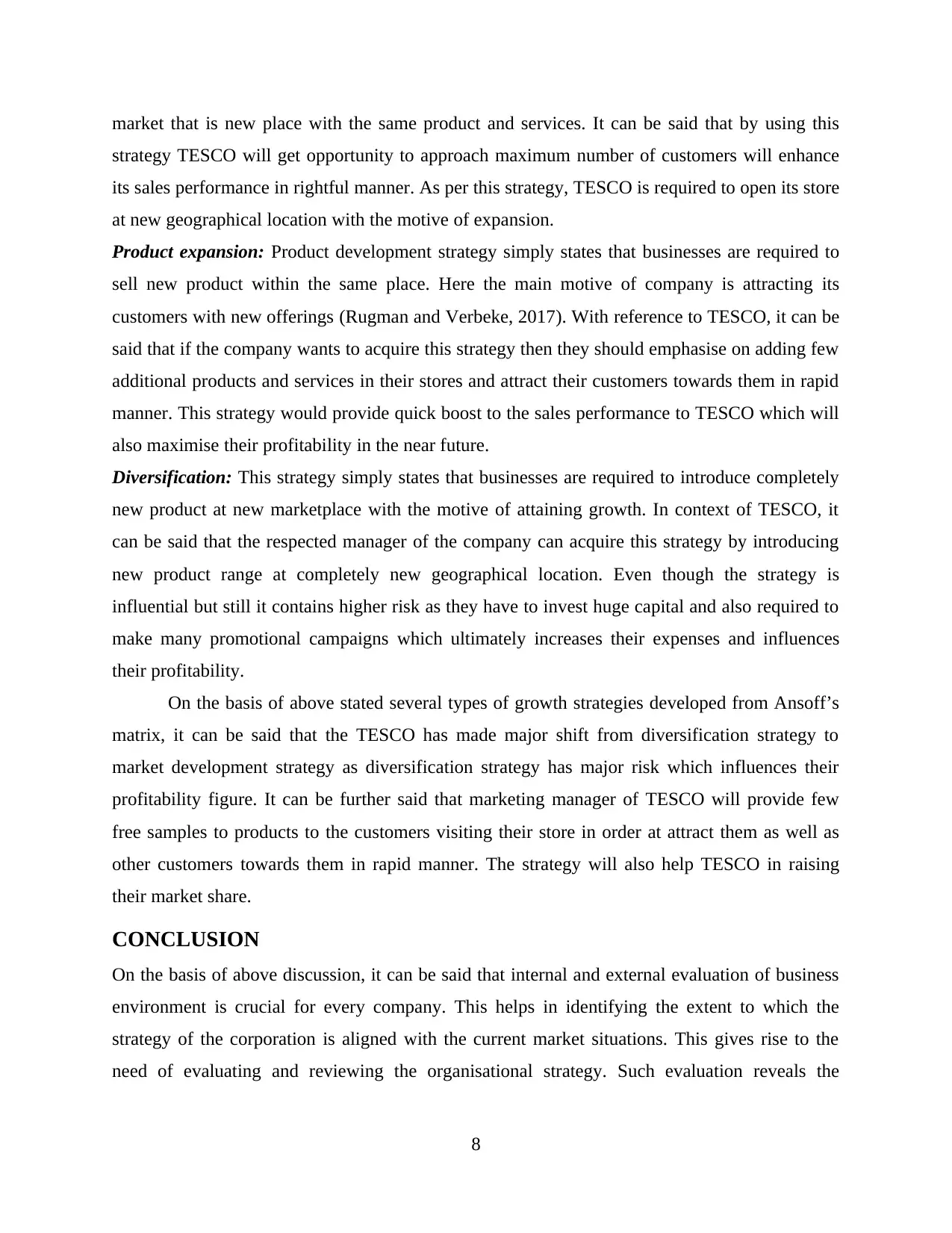
market that is new place with the same product and services. It can be said that by using this
strategy TESCO will get opportunity to approach maximum number of customers will enhance
its sales performance in rightful manner. As per this strategy, TESCO is required to open its store
at new geographical location with the motive of expansion.
Product expansion: Product development strategy simply states that businesses are required to
sell new product within the same place. Here the main motive of company is attracting its
customers with new offerings (Rugman and Verbeke, 2017). With reference to TESCO, it can be
said that if the company wants to acquire this strategy then they should emphasise on adding few
additional products and services in their stores and attract their customers towards them in rapid
manner. This strategy would provide quick boost to the sales performance to TESCO which will
also maximise their profitability in the near future.
Diversification: This strategy simply states that businesses are required to introduce completely
new product at new marketplace with the motive of attaining growth. In context of TESCO, it
can be said that the respected manager of the company can acquire this strategy by introducing
new product range at completely new geographical location. Even though the strategy is
influential but still it contains higher risk as they have to invest huge capital and also required to
make many promotional campaigns which ultimately increases their expenses and influences
their profitability.
On the basis of above stated several types of growth strategies developed from Ansoff’s
matrix, it can be said that the TESCO has made major shift from diversification strategy to
market development strategy as diversification strategy has major risk which influences their
profitability figure. It can be further said that marketing manager of TESCO will provide few
free samples to products to the customers visiting their store in order at attract them as well as
other customers towards them in rapid manner. The strategy will also help TESCO in raising
their market share.
CONCLUSION
On the basis of above discussion, it can be said that internal and external evaluation of business
environment is crucial for every company. This helps in identifying the extent to which the
strategy of the corporation is aligned with the current market situations. This gives rise to the
need of evaluating and reviewing the organisational strategy. Such evaluation reveals the
8
strategy TESCO will get opportunity to approach maximum number of customers will enhance
its sales performance in rightful manner. As per this strategy, TESCO is required to open its store
at new geographical location with the motive of expansion.
Product expansion: Product development strategy simply states that businesses are required to
sell new product within the same place. Here the main motive of company is attracting its
customers with new offerings (Rugman and Verbeke, 2017). With reference to TESCO, it can be
said that if the company wants to acquire this strategy then they should emphasise on adding few
additional products and services in their stores and attract their customers towards them in rapid
manner. This strategy would provide quick boost to the sales performance to TESCO which will
also maximise their profitability in the near future.
Diversification: This strategy simply states that businesses are required to introduce completely
new product at new marketplace with the motive of attaining growth. In context of TESCO, it
can be said that the respected manager of the company can acquire this strategy by introducing
new product range at completely new geographical location. Even though the strategy is
influential but still it contains higher risk as they have to invest huge capital and also required to
make many promotional campaigns which ultimately increases their expenses and influences
their profitability.
On the basis of above stated several types of growth strategies developed from Ansoff’s
matrix, it can be said that the TESCO has made major shift from diversification strategy to
market development strategy as diversification strategy has major risk which influences their
profitability figure. It can be further said that marketing manager of TESCO will provide few
free samples to products to the customers visiting their store in order at attract them as well as
other customers towards them in rapid manner. The strategy will also help TESCO in raising
their market share.
CONCLUSION
On the basis of above discussion, it can be said that internal and external evaluation of business
environment is crucial for every company. This helps in identifying the extent to which the
strategy of the corporation is aligned with the current market situations. This gives rise to the
need of evaluating and reviewing the organisational strategy. Such evaluation reveals the
8
Paraphrase This Document
Need a fresh take? Get an instant paraphrase of this document with our AI Paraphraser
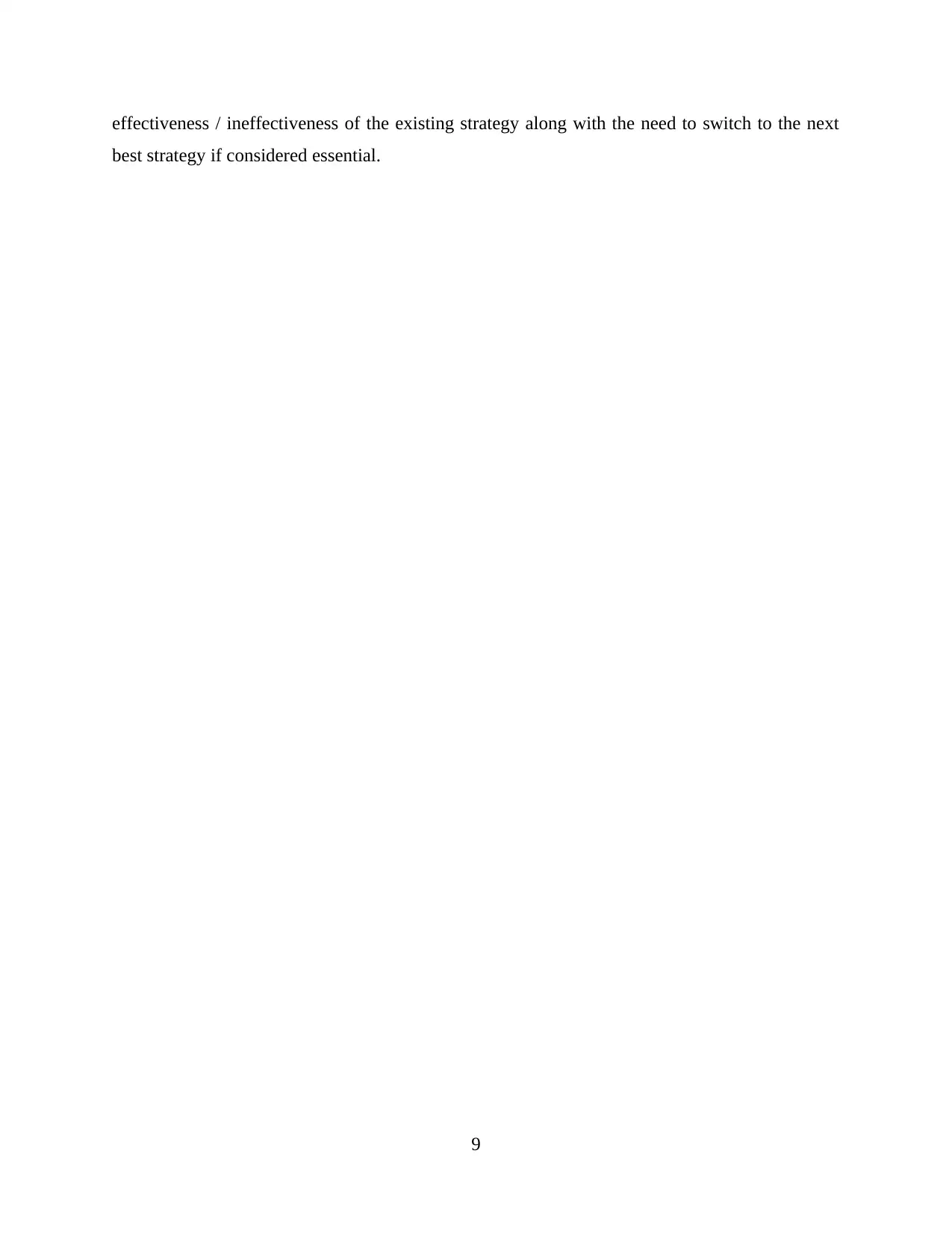
effectiveness / ineffectiveness of the existing strategy along with the need to switch to the next
best strategy if considered essential.
9
best strategy if considered essential.
9
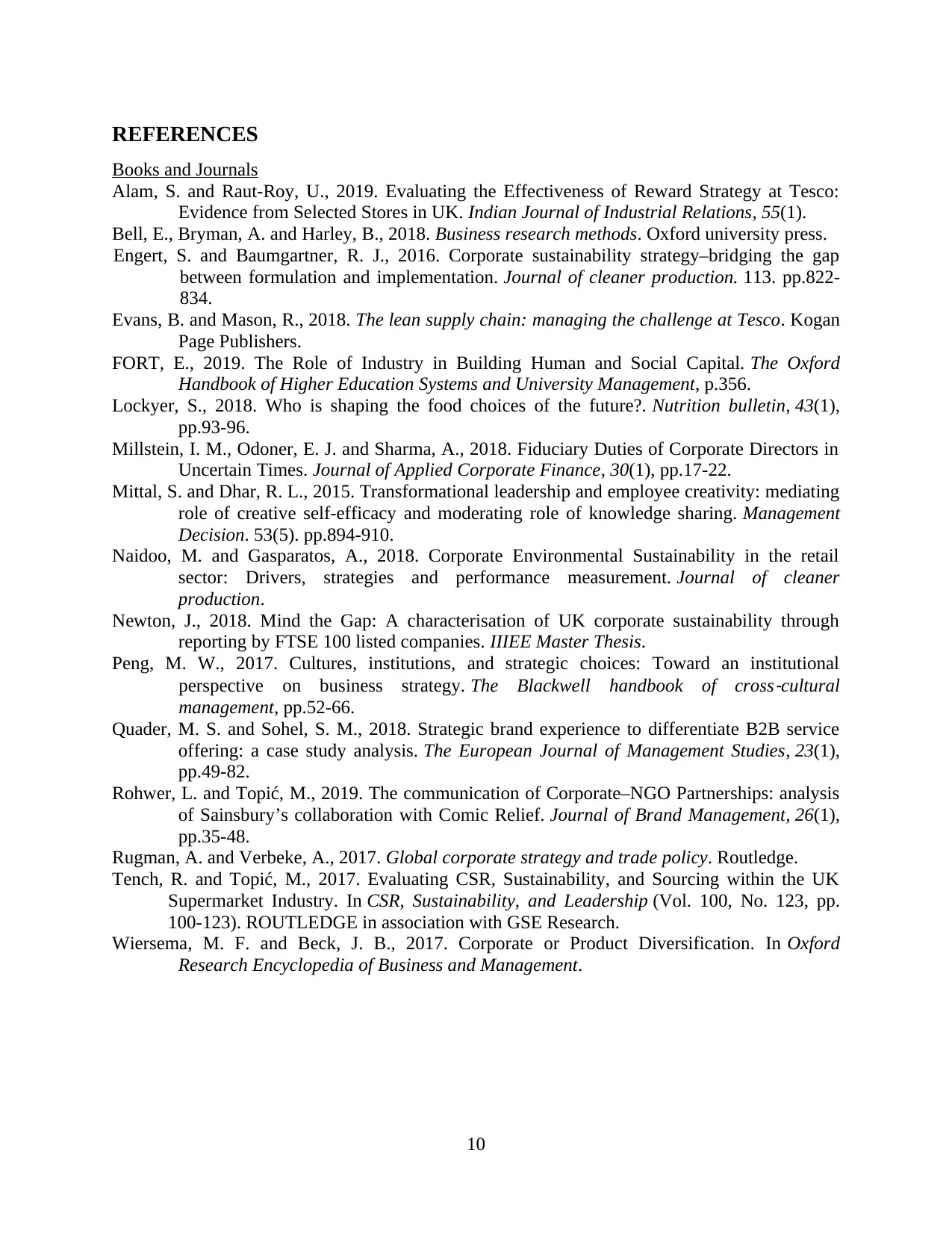
REFERENCES
Books and Journals
Alam, S. and Raut-Roy, U., 2019. Evaluating the Effectiveness of Reward Strategy at Tesco:
Evidence from Selected Stores in UK. Indian Journal of Industrial Relations, 55(1).
Bell, E., Bryman, A. and Harley, B., 2018. Business research methods. Oxford university press.
Engert, S. and Baumgartner, R. J., 2016. Corporate sustainability strategy–bridging the gap
between formulation and implementation. Journal of cleaner production. 113. pp.822-
834.
Evans, B. and Mason, R., 2018. The lean supply chain: managing the challenge at Tesco. Kogan
Page Publishers.
FORT, E., 2019. The Role of Industry in Building Human and Social Capital. The Oxford
Handbook of Higher Education Systems and University Management, p.356.
Lockyer, S., 2018. Who is shaping the food choices of the future?. Nutrition bulletin, 43(1),
pp.93-96.
Millstein, I. M., Odoner, E. J. and Sharma, A., 2018. Fiduciary Duties of Corporate Directors in
Uncertain Times. Journal of Applied Corporate Finance, 30(1), pp.17-22.
Mittal, S. and Dhar, R. L., 2015. Transformational leadership and employee creativity: mediating
role of creative self-efficacy and moderating role of knowledge sharing. Management
Decision. 53(5). pp.894-910.
Naidoo, M. and Gasparatos, A., 2018. Corporate Environmental Sustainability in the retail
sector: Drivers, strategies and performance measurement. Journal of cleaner
production.
Newton, J., 2018. Mind the Gap: A characterisation of UK corporate sustainability through
reporting by FTSE 100 listed companies. IIIEE Master Thesis.
Peng, M. W., 2017. Cultures, institutions, and strategic choices: Toward an institutional
perspective on business strategy. The Blackwell handbook of cross
‐cultural
management, pp.52-66.
Quader, M. S. and Sohel, S. M., 2018. Strategic brand experience to differentiate B2B service
offering: a case study analysis. The European Journal of Management Studies, 23(1),
pp.49-82.
Rohwer, L. and Topić, M., 2019. The communication of Corporate–NGO Partnerships: analysis
of Sainsbury’s collaboration with Comic Relief. Journal of Brand Management, 26(1),
pp.35-48.
Rugman, A. and Verbeke, A., 2017. Global corporate strategy and trade policy. Routledge.
Tench, R. and Topić, M., 2017. Evaluating CSR, Sustainability, and Sourcing within the UK
Supermarket Industry. In CSR, Sustainability, and Leadership (Vol. 100, No. 123, pp.
100-123). ROUTLEDGE in association with GSE Research.
Wiersema, M. F. and Beck, J. B., 2017. Corporate or Product Diversification. In Oxford
Research Encyclopedia of Business and Management.
10
Books and Journals
Alam, S. and Raut-Roy, U., 2019. Evaluating the Effectiveness of Reward Strategy at Tesco:
Evidence from Selected Stores in UK. Indian Journal of Industrial Relations, 55(1).
Bell, E., Bryman, A. and Harley, B., 2018. Business research methods. Oxford university press.
Engert, S. and Baumgartner, R. J., 2016. Corporate sustainability strategy–bridging the gap
between formulation and implementation. Journal of cleaner production. 113. pp.822-
834.
Evans, B. and Mason, R., 2018. The lean supply chain: managing the challenge at Tesco. Kogan
Page Publishers.
FORT, E., 2019. The Role of Industry in Building Human and Social Capital. The Oxford
Handbook of Higher Education Systems and University Management, p.356.
Lockyer, S., 2018. Who is shaping the food choices of the future?. Nutrition bulletin, 43(1),
pp.93-96.
Millstein, I. M., Odoner, E. J. and Sharma, A., 2018. Fiduciary Duties of Corporate Directors in
Uncertain Times. Journal of Applied Corporate Finance, 30(1), pp.17-22.
Mittal, S. and Dhar, R. L., 2015. Transformational leadership and employee creativity: mediating
role of creative self-efficacy and moderating role of knowledge sharing. Management
Decision. 53(5). pp.894-910.
Naidoo, M. and Gasparatos, A., 2018. Corporate Environmental Sustainability in the retail
sector: Drivers, strategies and performance measurement. Journal of cleaner
production.
Newton, J., 2018. Mind the Gap: A characterisation of UK corporate sustainability through
reporting by FTSE 100 listed companies. IIIEE Master Thesis.
Peng, M. W., 2017. Cultures, institutions, and strategic choices: Toward an institutional
perspective on business strategy. The Blackwell handbook of cross
‐cultural
management, pp.52-66.
Quader, M. S. and Sohel, S. M., 2018. Strategic brand experience to differentiate B2B service
offering: a case study analysis. The European Journal of Management Studies, 23(1),
pp.49-82.
Rohwer, L. and Topić, M., 2019. The communication of Corporate–NGO Partnerships: analysis
of Sainsbury’s collaboration with Comic Relief. Journal of Brand Management, 26(1),
pp.35-48.
Rugman, A. and Verbeke, A., 2017. Global corporate strategy and trade policy. Routledge.
Tench, R. and Topić, M., 2017. Evaluating CSR, Sustainability, and Sourcing within the UK
Supermarket Industry. In CSR, Sustainability, and Leadership (Vol. 100, No. 123, pp.
100-123). ROUTLEDGE in association with GSE Research.
Wiersema, M. F. and Beck, J. B., 2017. Corporate or Product Diversification. In Oxford
Research Encyclopedia of Business and Management.
10
⊘ This is a preview!⊘
Do you want full access?
Subscribe today to unlock all pages.

Trusted by 1+ million students worldwide
1 out of 12
Related Documents
Your All-in-One AI-Powered Toolkit for Academic Success.
+13062052269
info@desklib.com
Available 24*7 on WhatsApp / Email
![[object Object]](/_next/static/media/star-bottom.7253800d.svg)
Unlock your academic potential
Copyright © 2020–2025 A2Z Services. All Rights Reserved. Developed and managed by ZUCOL.





